For the 2025 school year, there are 2 public middle schools serving 314 students in Fairfield City School District. This district's average middle testing ranking is 2/10, which is in the bottom 50% of public middle schools in Alabama.
Public Middle Schools in Fairfield City School District have an average math proficiency score of 5% (versus the Alabama public middle school average of 21%), and reading proficiency score of 27% (versus the 46% statewide average).
Minority enrollment is 100% of the student body (majority Black), which is more than the Alabama public middle school average of 45% (majority Black).
Overview
This School District
This State (AL)
# Schools
6 Schools
534 Schools
# Students
1,321 Students
236,737 Students
# Teachers
69 Teachers
12,843 Teachers
Student : Teacher Ratio
19:1
19:1
District Rank
Fairfield City School District, which is ranked within the bottom 50% of all 145 school districts in Alabama (based off of combined math and reading proficiency testing data) for the 2021-2022 school year.
The school district's graduation rate of 90-94% has increased from 85-89% over five school years.
Overall District Rank
#136 out of 145 school districts
(Bottom 50%)
(Bottom 50%)
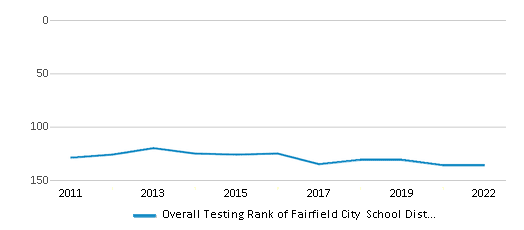
Math Test Scores (% Proficient)
4%
29%
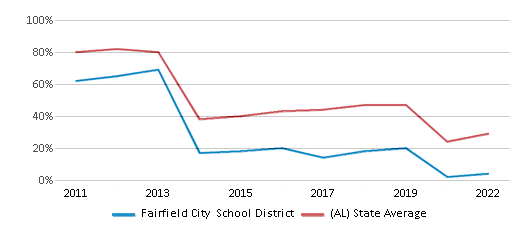
Reading/Language Arts Test Scores (% Proficient)
21%
47%
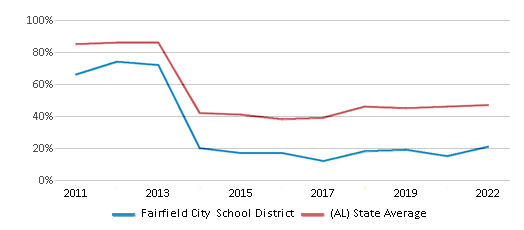
Science Test Scores (% Proficient)
8%
38%
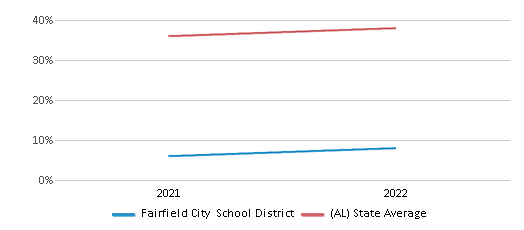
Graduation Rate
90-94%
88%
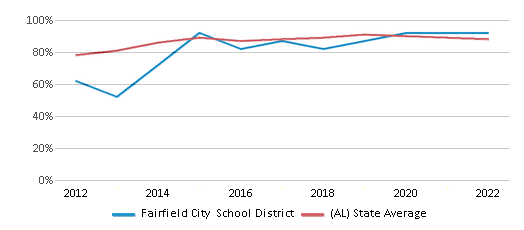
Students by Ethnicity:
Diversity Score
0.11
0.61
# American Indian Students
1 Student
3,329 Students
% American Indian Students
n/a
2%
# Asian Students
n/a
2,720 Students
% Asian Students
n/a
1%
# Hispanic Students
61 Students
24,370 Students
% Hispanic Students
5%
10%
# Black Students
1,242 Students
68,686 Students
% Black Students
94%
29%
# White Students
4 Students
129,762 Students
% White Students
n/a
55%
# Hawaiian Students
n/a
257 Students
% Hawaiian Students
n/a
n/a
# Two or more races Students
13 Students
7,613 Students
% of Two or more races Students
1%
3%
Students by Grade:
# Students in PK Grade:
-
2,540
# Students in K Grade:
89
5,092
# Students in 1st Grade:
71
5,246
# Students in 2nd Grade:
88
5,239
# Students in 3rd Grade:
74
5,011
# Students in 4th Grade:
104
5,480
# Students in 5th Grade:
101
10,423
# Students in 6th Grade:
105
39,140
# Students in 7th Grade:
104
55,757
# Students in 8th Grade:
105
56,367
# Students in 9th Grade:
125
13,737
# Students in 10th Grade:
119
11,591
# Students in 11th Grade:
122
10,975
# Students in 12th Grade:
114
10,139
# Ungraded Students:
-
-
District Revenue and Spending
The revenue/student of $15,515 is higher than the state median of $13,006. The school district revenue/student has grown by 36% over four school years.
The school district's spending/student of $15,216 is higher than the state median of $12,220. The school district spending/student has grown by 43% over four school years.
Total Revenue
$21 MM
$9,671 MM

Spending
$20 MM
$9,086 MM
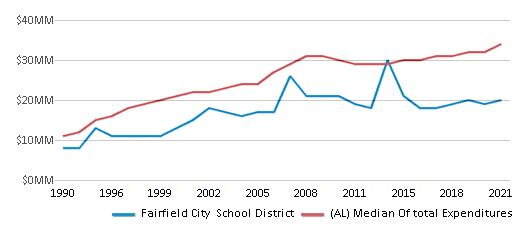
Revenue / Student (19-20)
$15,515
$13,006
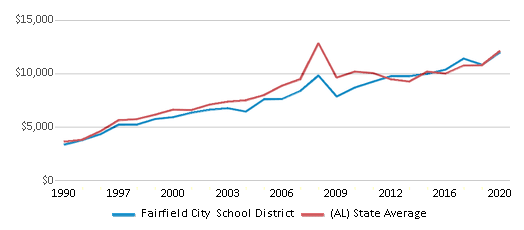
Spending / Student (19-20)
$15,216
$12,220
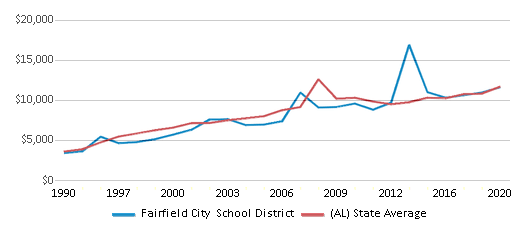
Best Fairfield City School District Public Middle Schools (2025)
School
(Math and Reading Proficiency)
(Math and Reading Proficiency)
Location
Grades
Students
Rank: #11.
C J Donald Middle School
(Math: ≤5% | Reading: 25-29%)
Rank:
Rank:
2/
Bottom 50%10
715 Valley Rd
Fairfield, AL 35064
(205) 783-6823
Fairfield, AL 35064
(205) 783-6823
Grades: 6-8
| 314 students
Rank: n/an/a
Fairfield Alternative School
Alternative School
6405 Ave D
Fairfield, AL 35064
(205) 783-6847
Fairfield, AL 35064
(205) 783-6847
Grades: K-12
| n/a students
Recent Articles

Year-Round Or Traditional Schedule?
Which is more appropriate for your child? A year-round attendance schedule or traditional schedule? We look at the pros and cons.

Why You Should Encourage Your Child to Join a Sports Team
Participating in team sports has a great many benefits for children, there is no doubt. In this article you will learn what those benefits are.

White Students are Now the Minority in U.S. Public Schools
Increasing birth rates among immigrant families from Asia and Central and South America, combined with lower birth rates among white families, means that for the first time in history, public school students in the United States are majority-minority. This shift in demographics poses difficulties for schools as they work to accommodate children of varying language abilities and socio-economic backgrounds.





